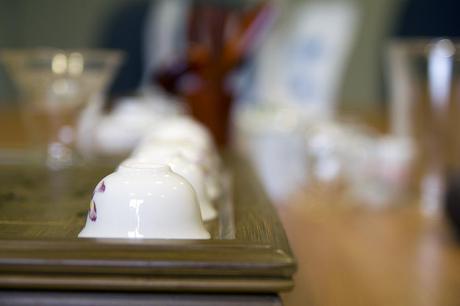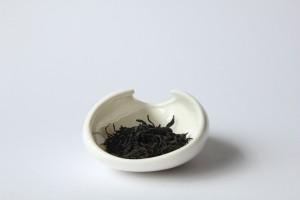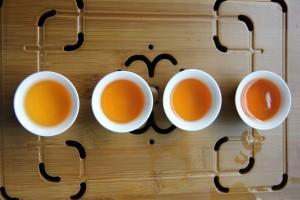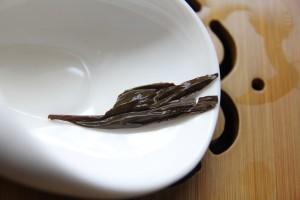Very often I’ve heard people say “it’s hard to write a tea journal, I don’t know enough descriptors”.
Well, it depends essentially on what’s your motivation for writing it.
If your motivation is to impress others then I suggest you stop reading this. In fact, you can stop reading serious tea related writings and read more literary or poetic fiction.
“….. with its deliberately garish magentas, its scandalous neon greens, the dance is not of bodies but of tongues, and the tongues of the highly colored figures whispering lick-lick-lick into one another’s ears are black, black, black.”
Taken from Salman Rushdie’s The Moor’s Last Sigh, this paragraph is not describing tea but its style and prose evokes many a fanciful tea review. Throw in obscure references to weird herbs and fruits that few people ever heard of- “25 year old Goji berry infused in ’87 Chardonnay seasoned in the cellar of a Scottish castle”- and you will impress people soon enough with your sophisticated palate.
For good measure invent creative analogies such as “The mouth feel was like a silver chain dragging its way across your tongue before the fluttering hummingbird emerged from its shadow and smothered the entire mouth with her silky smoothness.”

Of course it tells the reader nothing about the tea but hey, who cares, that was never the focus.
I will go right out and say if this is how you journal your tea journey, you could drink tea for decades and learn little.
There are some reasons that one might want to keep a journal of tea tastings
i) Chronicle the changes of a tea over time- especially for a Pu-er bing or other aged teas
ii) Learn and identify the factors that influence the taste of tea
iii) Assess the quality and value of tea
iv) Help your friends determine whether or not to make a purchase
v) Improve your own brewing methods
It helps to record certain details that you can one day come back and identify when you learn something new.
For example you might record that the wet leaves of your Wuyi Yancha is very rough, like a toad’s skin though it may mean nothing initially. Later when you learn that it is because of the high firing of traditional Yancha that causes ‘blisters’ to appear on the surface of the leaves and you can relate to your notes.
What to Journal in a Tea Tasting
i) Details of tea- variety, harvest year, vendor, storage, production area
ii) Brewing parameters- quantity, water temperature infusion time
iii) Brewing vessel
iv) Brewing Method
v) Appearance of Dry Leaves
vi) Aroma of Dry Leaves
vii) Aroma of Lid after infusion
viii) Liquor Color
ix) Aroma after a minute or so- compare with vii)
x) Initial taste of tea
xi) Texture and mouth feel
xii) Emergence of huigan (recurring sweetness) if any
xiii) Lingering after taste
xiv) Aroma on cup after the tea is consumed
xv) Aroma of wet leaves
xvi) Evaluate if brewing adjustment is needed
xvii) Re-infuse and repeat vii) to xv) while recording infusion time for each or adjustments to water temperature or quantity of leaves (if applicable)
xviii) Appearance of wet leaves
What to look out for:
 Appearances of dry leaves:
Appearances of dry leaves:

i) How tightly the leaves are rolled
ii) Evenness
iii) Color
iv) Size
v) Sturdiness
vi) Tenderness
vii) Appearance of downy hair aka fur
viii) Shine
ix) Texture and feel
x) Dryness- powdery residue is indicative of dry and well-stored tea for many leaves
Usually just a couple of words will do, tightly wound, not tightly wound, a bit of fur, furry etc.
Aroma of dry leaves:
i) Freshness
ii) Aroma
iii) Intensity of aroma
iv) ‘Fire smell’
v) Foreign smells- sourness, overstewed etc
Aroma of Lid, Liquor and Wet Leaves:
i) Intensity
ii) How far it carries
iii) Whether it lasts
iv) Sharpness
v) Purity
vi) ‘Over-brewed’, yellowness in green tea?
vii) Chestnut?
viii) Beans?
ix) Caramel?
x) Fruit?
xi) Floral?
xii) Seaweed?
xiii) Grassy?
Appearance of Liquor

ii) Clarity
iii) Shine
Taste, Mouth Feel
i) Freshness
ii) ‘Cooling’, hydrating quality
iii) Intensity
iv) Thickness
v) Viscosity and Body
vi) Tightness in the mouth
vii) Sweetness- when does it appear
viii) Bitterness- when does it appear
ix) Sourness- when does it appear
x) Astringency- drying feel
If sweetness appears first than bitterness lingers its indicative of mediocre quality but if bitterness appears first but is replaced by sweetness it means the tea is of good quality
Aftertaste
i) Huigan- a sweetness that wells up in the throat- how soon it comes, intensity and how long it lingers
ii) How long does the taste linger in the mouth
iii) Can you feel it on your teeth and the roof of your mouth
iv) What is the final taste? Sweet or Bitter
Wet Leaves

ii) Color
iii) Color of sides, stems etc
iv) Thickness
v) Texture
vi) Shine
Some of these may not mean anything at this stage but as your tea journey continues, you may learn something related to the unique geography of the harvest area or production methods and you can relate back to your tasting notes.
Also you may be able to chronicle the development of a tea over time, for example an aged pu-er bing or a high fired Yancha.
It will be interesting to evaluate the effect of a brewing utensil or your brewing methods or parameters on the taste of tea.
In my opinion, for journaling you should keep it simple but detailed. There is no sense in fanciful “it left my mouth resonating like a bronze bell that was struck by a seasoned cast iron hammer” unless you are submitting it as a work of literature.
Even if the tea taste like ‘foie gras served with caramelized apple with a hint of truffles’, that might sound delicious to eat but disgusting to drink.
Stick to the descriptions that are indicative of quality and useful for evaluation of the tea and your own journey.
